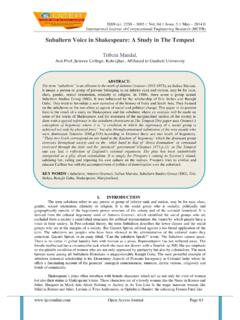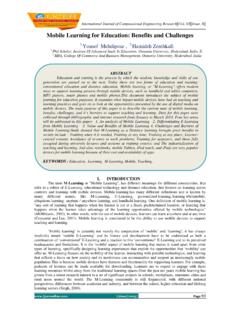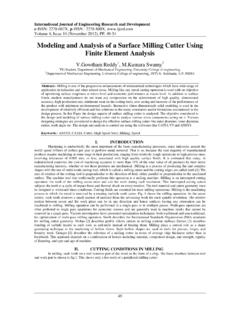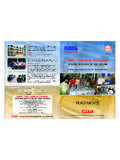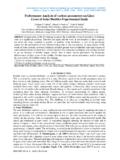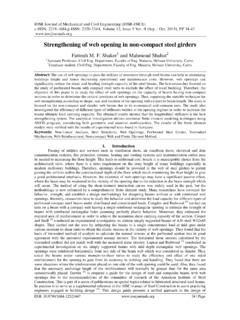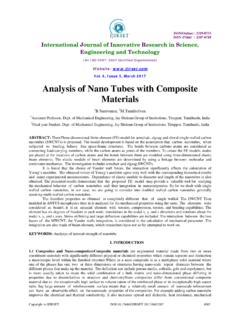Transcription of Design & Analysis of a Two-jaw parallel Pneumatic Gripper
1 International Journal Of Computational Engineering Research ( ) Vol. 03 Issue. 12 || Issn 2250-3005(online) || ||December| 2013 || Page 41 Design & Analysis of a Two-jaw parallel Pneumatic Gripper , Prasad2, Raffi Mohammed3 1PG Student, Department of Mechanical Engineering, Nimra college of Engineeri2 Assistant Professor, Department of Mechanical Engineering ng and Technology. 2 Professor & HOD, Department of Mechanical Engineering, Nimra College of Engineering & Technology, Vijayawada, AP, INDIA 3 Assistant Professor, Department of Mechanical Engineering, NRI institute of Technology, Vijayawada, AP, INDIA I.
2 INTRODUCTION Compressed Air is the air under pressure having values much greater than that of the atmosphere. When this compressed air is expanded to a lower pressure, a piston can be pushed using it, such as that in a jackhammer; it can go through small air turbines to turn shaft, as in a high-speed dental drill; or it can be expanded through a nozzle to produce a high-speed jet as in a paint sprayer. There are many Pneumatic devices in which compressed air becomes a source of energy to perform various operations which includes riveting guns, air powered hammers, drills such as rock drills and other air powered tools.
3 There are methods to use compressed air in coal mining tools thus reducing any chances of explosion which happens in case of electric tools which generally produces spark. II. WORKING PRINCIPLE The parallel jaw Gripper has at least two fingers which can be moved towards each other along one axis. Usually, the fingers can be moved independently from each other in order not to shift the object, but they are only able to perform simple operations like open and close. Thereby, a longitudinal or side movement is impossible. A parallel jaw perform, a manual control to steer the Gripper must be possible for enabling the highest flexibility.
4 The principles which are followed in this type of parallel jaw Gripper are: The force closure grip: The characteristic of the force closure grip is that the Gripper keeps the object in a stable state by compensating all forces and torques created by the object. The sum of all forces and sum of all torques must equal zero( F=0; M=0). The force closure grip can be differentiated into a grip with friction and without friction. The force closure grip without friction is much idealized and not very common in daily use; therefore it is no further mentioned. The force closure grip with friction requires at least contact points for gripping a planar object and at least 4 contact points for a three-dimensional object.
5 Abstract: The handling of abstract materials and mechanisms to pick and place are widely found in factory automation and industrial manufacturing. There are different mechanical grippers which are based on different motor technologies have been designed and employed in numerous applications. The designed robotic Gripper in this paper is a two jaw actuated Gripper which is different from the conventional cam and follower Gripper in the way that controlled movement of the jaws is done with the help of Pneumatic cylinders using air pressure.
6 The force developed in the cylinder is very gentle and is directly delivered to the jaws in a compact way. The Design , Analysis and fabrication of the Gripper model are explained in details along with the detailed list of all existing Pneumatic grippers in market. The force and torque for the Gripper have been calculated for different set of conditions. The working of the model is checked for and observation for pay load is recorded at various pressures. The highly dynamic and highly accelerated Gripper model can be easily set at intermediate positions by regulating the pressure.
7 Pneumatic grippers are very easy to handle and are generally cost-effective because air hoses, valves and other Pneumatic devices are easy to maintain. Keywords: Automation, air hoses, Ansys, Gripper , jaws, Pro-E. Design & Analysis of a Two-jaw parallel Pneumatic Gripper || Issn 2250-3005(online) || ||December| 2013 || Page 42 The form closure grip is the second principle for gripping objects. This grip is feasible, because the Gripper is a negative model of the object (or a part of it) which limits the movement of the object within the Gripper in any direction, also when changing the Gripper orientation.
8 The force is compensated on well specified contact surfaces. Tangential load, pressure load and torque are not considered, but are instead reduced to the corresponding forces. The Gripper must either make use of a special geometry ( negative model of the object), or a significant number of fingers are required. When compressed air is released from the compressor through the pressure regulator, it rapidly flows into the 5/2 way valve. The desired pressure level can be maintained by observing the pressure readings on the dial gauge. The maximum pressure at which the system can be operated is 10 bar, but mostly we will be working at pressure levels far below that, preferably less than 5 bar.
9 The compressed air moves into the 5/2 way valve which when activated either manually or by solenoid electric circuit allows the compressed air into the inlet port of the two double acting air cylinder(max supply pressure of 10 bar) which are placed exactly opposite to each other. A 5/2 way valve could be used in place of a 5/3 way valve which is an advanced valve which regulates the amount of compresses air flow, thus controlling the stroke length of the piston rods. The cylinder has a bore diameter of 50 mm and stroke of 50 mm too. The entry of air into the cylinder pushes the piston and thus the piston rods undergoes a power stroke to move outwards which increases the distance between the Gripper surfaces.
10 Thus this movement opens the grippers which helps in releasing the object. For the other way round, when the compressed air flow is reversed then the air flows out from the cylinder into the valve and into the compressor through the regulator. This accounts for the return stroke of the piston rod which helps to grasp the load as the distance between the Gripper surfaces decreases. The pressure is maintained as per the gripping force which is required. The distance between the grippers is the width of the object which is required to be grasped. III. ROBOTIC GRIPPERS These are the type of robots which have the capability to grasp definite objects and then reposition it according to requirement.

